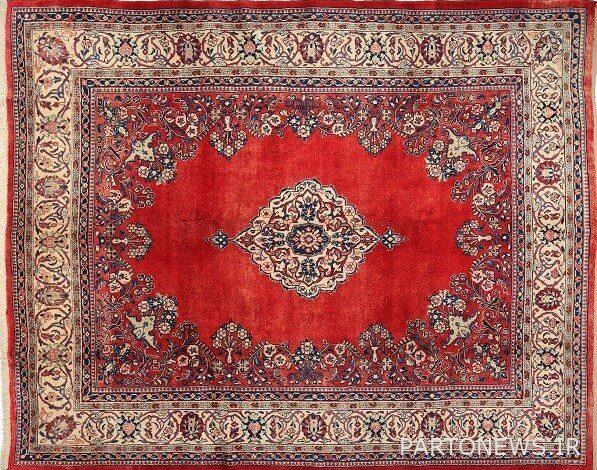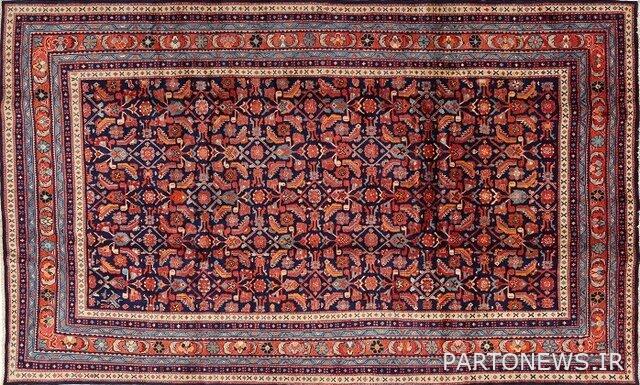150 years old Arak carpets

Iranian carpet is a mirror of the whole culture, originality and art of Iran. This original art has been kept alive in ancient times by the art of hand weavers and by Iranian culture and is one of the oldest and most original arts among Iranians.
In an interview with ISNA, Abdullah Ahrari, a member of the Iranian Scientific Carpet Association, spoke about the value of Arak carpets and said: In Markazi province, cities such as Arak, Mahallat, Khomein and Saveh are the most important centers of carpet weaving and the history of carpet weaving in this province dates back to the Qajar period.
He added: “Around 1266, following the industrial revolution that took place in Europe and the import of European countries to Iran began, the Europeans decided to export valuable goods from Iran to Europe in return for their large imports to Iran.”
A member of the Iranian Carpet Scientific Association continued: “Considering the comparative advantage of carpets among all goods, it was decided to export carpets instead of gold, which was threatened by dangers such as bandits.” Following this decision, Ziegler Company was established in Arak and carpets were produced for European and American countries, and these companies had somehow become the producers of this carpet. In addition to Ziegler Company, other companies such as the Italian company Karzali Brothers, Shahanian, Salim and Qali Shargh Company started operating in Markazi province, especially in Arak, which is the former Sultanabad.
Chicken and fish map of famous Arak carpet designs
Ahrari pointed out: Carpet weaving became common in Arak city and surrounding villages about 150 years ago. One of the famous carpet weaving designs in this city is the chicken and fish map, which is very similar to the mixed fish carpet of Khorasan.
He specified: The map of fish dirhams in Arak carpets are also known as fish, Zanbouri and Farahan fish. The floral design that is not so common at the moment and designs such as underground, bouquet, vase are among the most famous carpet designs in Arak.
A member of the Iranian Scientific Carpet Association said about the applied colors of this carpet: “Basically, some of the colors used in Arak carpets have their own terms, for example, the color of buttermilk, which is usually called light blue in Khorasan carpets, is red in Arak carpets.” they say; Because when the carpet is painted with ronas, then it is soaked in doogh to get a clear color.
Ahrari added: Colors such as crimson, green, beige, fawn, blue types, different browns and other colors are the colors that are widely used in Arak carpets.
He said: “In the past, natural dyes were used to weave carpets, but today, except for famous carpets such as Farahan carpets, which are brands of Arak carpets, most Arak carpet manufacturers use chemical dyes.”
A member of the Iranian Carpet Scientific Association explained about the other characteristics of Arak carpets: The raw materials used in Arak carpets are mostly wool and cotton. The common dimensions of this carpet in Arak reach 12 meters, of course, these carpets are woven in dimensions of 6 meters and 9 meters.
Ahrari added: “According to the number of villages and cities that are closer to Qom and Kashan, their number is 40 and 45, and the density of carpets that are closer to the east and south of Arak does not exceed 30 and 25.”
Arak carpets are mostly woven with the Persian group
He added: Arak carpets are mostly woven with Persian knots and their heads are done during weaving and polishing and after weaving. The carpet weaving poles that are woven in Arak are mostly vertical poles and its weaving style is Persian weaving. Most of the carpets in Arak are of the bipod type, and if we want to name its designers, we can name people like “Assadollah Daqiqi”, “Abdul Karim Rajhi”, “Ezatullah Ebrahimi”.
A member of the Iranian Carpet Scientific Association said: As mentioned, especially in the Qajar period until the advent of the first Pahlavi and the establishment of the Iranian Carpet Company in 1314, the production and trade of this carpet was mainly in the hands of foreign and multinational companies.
In this regard, Ahrari told a story from the period of Nasser al-Din Shah and stated: During the reign of Nasser al-Din Shah, Ziegler Company had imprisoned a number of carpet manufacturers who had not delivered the carpet after weaving and sold it in their favor. The carpet weavers also wrote to the Shah, and Nasser al-Din Shah did not take any action at this time, writing only a letter to the governor of Arak, in which he asked for some kind of mediation between these foreign companies and the carpet weavers. On the other hand, after the time of Nasser al-Din Shah, who was returning from a European trip to Iran, on his way to Iraq, he encountered some carpet weavers who had complaints from multinational companies selling this carpet, and he responded by pointing only five fingers at the sign. The union demands their return to work.

He continued: “Of course, it should be said that these multinational companies also had a positive dimension, and the expansion of carpet weaving in the region was one of these positive dimensions.” But unfortunately, the great need of Europe and the United States for Iranian carpets at that time, and on the other hand, the profitability of these companies forced them to shorten the designs. As a result, parts of the map were removed so that the carpets could be produced sooner.
A member of the Iranian Carpet Scientific Association added: “Among the maps that were heavily manipulated was a map called Sarooq, which was named after a village of the same name near Arak.” This region was once one of the best producers of Araki carpets. These rugs were later abbreviated to American Sarooq because they were somewhat abbreviated.

